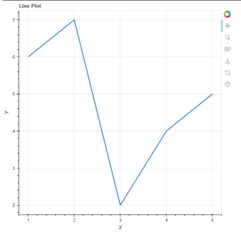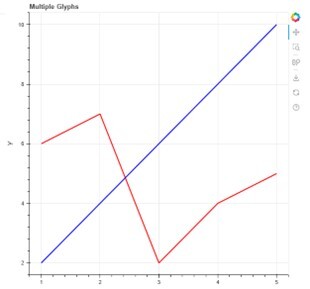Create drawings with multiple glyphs using Python Bokeh
Bokeh is a powerful data visualization library in Python that helps to create interactive and unique visualizations for the web. Bokeh supports various rendering techniques and provides a wide range of built-in tools for creating complex visualizations with multiple glyphs. This document will guide you through the process of creating a plot with multiple glyphs using Bokeh. This plot combines different glyphs to display multiple data series in a single plot that provides a more efficient way to understand the relationship between different variables.
What are glyphs and what are their main advantages?
Glyphs are graphical representations of characters, symbols, or icons used in typography and graphic design. They are often used in the design and layout of text, and can include letters, numbers, punctuation marks, and other symbols.
Some key advantages of using glyphs include −
Improve readability− Glyphs can be designed to be very readable, allowing readers to understand the text more quickly and accurately.
Enhance aesthetics − Glyphs can be used to add visual interest and appeal to text, making it more visually appealing and interactive.
Consistency and Accuracy − Glyphs can be designed to be consistent in size, shape and style, ensuring text is easy to read and visually coherent.
Flexibility − Glyphs can be scaled and modified easily, making it possible to use them in a wide range of contexts and applications.
Internationalization − Glyphs can be used to represent characters and symbols in a variety of languages and writing systems, making them very useful in internationalization and localization.
Overall, glyphs are a powerful tool for typography and graphic design, and can help improve the legibility, aesthetics, consistency, and flexibility of text.
Statistical Significance of these
Glyphs themselves are not subject to statistical significance tests since they are not statistical data. However, the use of glyphs in typography and graphic design may be subject to statistical significance tests if they are used in the context of an experiment or study that involves statistical analysis. For example, if a study is examining the effects of different fonts on reading speed or comprehension, statistical tests may be used to determine whether any observed differences between the fonts are statistically significant.
In general, statistical significance tests are used to determine whether observed differences or effects are likely to be due to chance or random variation, or whether they are likely to reflect a true difference or effect in the population being studied. The specific test used depends on the research question, the type of data being analyzed, and the assumptions made about the data and population.
Therefore, while glyphs themselves are not subject to statistical significance tests, they may be used in the context of experiments or studies that are subject to statistical analysis to determine whether any observed differences or effects are statistically significant.
Prerequisites
Before we dive into the task few things should is expected to be installed onto your system −
List of recommended settings −
pip install pandas, bokeh
It is expected that the user will have access to any standalone IDE such as VS-Code, PyCharm, Atom or Sublime text.
Even online Python compilers can also be used such as Kaggle.com, Google Cloud platform or any other will do.
Updated version of Python. At the time of writing the article I have used 3.10.9 version.
Knowledge of using Jupyter notebook.
Understanding and applying virtual environments will be beneficial, but not required.
Also, the individual is expected to have a good understanding of statistics and mathematics.
Create basic chart
To create a plot, we first need to import the necessary modules, such as `Figure`, `ColumnDataSource`, and the desired glyphs. Here's an example code snippet that creates a line plot with a single glyph using Bokeh −
Syntax
from bokeh.plotting import figure, output_file, show
output_file("line.html")
p = figure(title="Line Plot", x_axis_label="X", y_axis_label="Y")
x = [1, 2, 3, 4, 5]
y = [6, 7, 2, 4, 5]
p.line(x, y, line_width=2)
show(p)
Output

This code will create a line plot with x-axis labeled as "X", y-axis labeled as "Y", and a title "Line Plot". The line plot will display five data points with their corresponding x and y values.
Add multiple glyphs to the chart
To add multiple glyphs to the plot, we need to use the `Figure` object's `multi_line()` function. The `multi_line()` function takes multiple sequences of x and y values and creates a line glyph for each of them. Here's an example code snippet to create a line plot with multiple glyphs −
from bokeh.plotting import figure, output_file, show
from bokeh.models import ColumnDataSource
output_file("multi_line.html")
p = figure(title="Multiple Glyphs", x_axis_label="X", y_axis_label="Y")
x1 = [1, 2, 3, 4, 5]
y1 = [6, 7, 2, 4, 5]
x2 = [1, 2, 3, 4, 5]
y2 = [2, 4, 6, 8, 10]
source = ColumnDataSource(data=dict(x1=x1, y1=y1, x2=x2, y2=y2))
p.multi_line(xs=[source.data["x1"], source.data["x2"]],
ys=[source.data["y1"], source.data["y2"]],
line_color=["red", "blue"], line_width=[2, 2])
show(p)
Output

Here, we created two sets of x and y values and stored them in a `ColumnDataSource` object. We then passed the two sequences of x and y values to the `multi_line()` function, along with the colors and line widths of the two glyphs. This will create a line plot with two glyphs, one in red color and one in blue color, each with their corresponding x and y values.
Final Program, Code
# Basic plot
from bokeh.plotting import figure, output_file, show
output_file("line.html")
p = figure(title="Line Plot", x_axis_label="X", y_axis_label="Y")
x = [1, 2, 3, 4, 5]
y = [6, 7, 2, 4, 5]
p.line(x, y, line_width=2)
show(p)
# Multiple graphs
from bokeh.plotting import figure, output_file, show
from bokeh.models import ColumnDataSource
output_file("multi_line.html")
p = figure(title="Multiple Glyphs", x_axis_label="X", y_axis_label="Y")
x1 = [1, 2, 3, 4, 5]
y1 = [6, 7, 2, 4, 5]
x2 = [1, 2, 3, 4, 5]
y2 = [2, 4, 6, 8, 10]
source = ColumnDataSource(data=dict(x1=x1, y1=y1, x2=x2, y2=y2))
p.multi_line(xs=[source.data["x1"], source.data["x2"]],
ys=[source.data["y1"], source.data["y2"]],
line_color=["red", "blue"], line_width=[2, 2])
show(p)
Conclusion
在本文档中,我们学习了如何使用Bokeh创建具有多个图元的图表。我们首先介绍了图元,然后使用单个图元创建了一个基本的折线图。然后,我们使用`Figure`对象的`multi_line()`函数向图表中添加了多个图元。使用Bokeh,可以轻松创建交互式可视化,帮助理解不同数据点之间的关系。Bokeh允许您以最小的努力创建美观的可视化,让您专注于分析数据,而不必担心可视化。
The above is the detailed content of Create drawings with multiple glyphs using Python Bokeh. For more information, please follow other related articles on the PHP Chinese website!

Hot AI Tools

Undresser.AI Undress
AI-powered app for creating realistic nude photos

AI Clothes Remover
Online AI tool for removing clothes from photos.

Undress AI Tool
Undress images for free

Clothoff.io
AI clothes remover

AI Hentai Generator
Generate AI Hentai for free.

Hot Article

Hot Tools

Notepad++7.3.1
Easy-to-use and free code editor

SublimeText3 Chinese version
Chinese version, very easy to use

Zend Studio 13.0.1
Powerful PHP integrated development environment

Dreamweaver CS6
Visual web development tools

SublimeText3 Mac version
God-level code editing software (SublimeText3)

Hot Topics
 How to Use Python to Find the Zipf Distribution of a Text File
Mar 05, 2025 am 09:58 AM
How to Use Python to Find the Zipf Distribution of a Text File
Mar 05, 2025 am 09:58 AM
This tutorial demonstrates how to use Python to process the statistical concept of Zipf's law and demonstrates the efficiency of Python's reading and sorting large text files when processing the law. You may be wondering what the term Zipf distribution means. To understand this term, we first need to define Zipf's law. Don't worry, I'll try to simplify the instructions. Zipf's Law Zipf's law simply means: in a large natural language corpus, the most frequently occurring words appear about twice as frequently as the second frequent words, three times as the third frequent words, four times as the fourth frequent words, and so on. Let's look at an example. If you look at the Brown corpus in American English, you will notice that the most frequent word is "th
 How Do I Use Beautiful Soup to Parse HTML?
Mar 10, 2025 pm 06:54 PM
How Do I Use Beautiful Soup to Parse HTML?
Mar 10, 2025 pm 06:54 PM
This article explains how to use Beautiful Soup, a Python library, to parse HTML. It details common methods like find(), find_all(), select(), and get_text() for data extraction, handling of diverse HTML structures and errors, and alternatives (Sel
 Mathematical Modules in Python: Statistics
Mar 09, 2025 am 11:40 AM
Mathematical Modules in Python: Statistics
Mar 09, 2025 am 11:40 AM
Python's statistics module provides powerful data statistical analysis capabilities to help us quickly understand the overall characteristics of data, such as biostatistics and business analysis. Instead of looking at data points one by one, just look at statistics such as mean or variance to discover trends and features in the original data that may be ignored, and compare large datasets more easily and effectively. This tutorial will explain how to calculate the mean and measure the degree of dispersion of the dataset. Unless otherwise stated, all functions in this module support the calculation of the mean() function instead of simply summing the average. Floating point numbers can also be used. import random import statistics from fracti
 How to Perform Deep Learning with TensorFlow or PyTorch?
Mar 10, 2025 pm 06:52 PM
How to Perform Deep Learning with TensorFlow or PyTorch?
Mar 10, 2025 pm 06:52 PM
This article compares TensorFlow and PyTorch for deep learning. It details the steps involved: data preparation, model building, training, evaluation, and deployment. Key differences between the frameworks, particularly regarding computational grap
 Serialization and Deserialization of Python Objects: Part 1
Mar 08, 2025 am 09:39 AM
Serialization and Deserialization of Python Objects: Part 1
Mar 08, 2025 am 09:39 AM
Serialization and deserialization of Python objects are key aspects of any non-trivial program. If you save something to a Python file, you do object serialization and deserialization if you read the configuration file, or if you respond to an HTTP request. In a sense, serialization and deserialization are the most boring things in the world. Who cares about all these formats and protocols? You want to persist or stream some Python objects and retrieve them in full at a later time. This is a great way to see the world on a conceptual level. However, on a practical level, the serialization scheme, format or protocol you choose may determine the speed, security, freedom of maintenance status, and other aspects of the program
 What are some popular Python libraries and their uses?
Mar 21, 2025 pm 06:46 PM
What are some popular Python libraries and their uses?
Mar 21, 2025 pm 06:46 PM
The article discusses popular Python libraries like NumPy, Pandas, Matplotlib, Scikit-learn, TensorFlow, Django, Flask, and Requests, detailing their uses in scientific computing, data analysis, visualization, machine learning, web development, and H
 Scraping Webpages in Python With Beautiful Soup: Search and DOM Modification
Mar 08, 2025 am 10:36 AM
Scraping Webpages in Python With Beautiful Soup: Search and DOM Modification
Mar 08, 2025 am 10:36 AM
This tutorial builds upon the previous introduction to Beautiful Soup, focusing on DOM manipulation beyond simple tree navigation. We'll explore efficient search methods and techniques for modifying HTML structure. One common DOM search method is ex
 How to Create Command-Line Interfaces (CLIs) with Python?
Mar 10, 2025 pm 06:48 PM
How to Create Command-Line Interfaces (CLIs) with Python?
Mar 10, 2025 pm 06:48 PM
This article guides Python developers on building command-line interfaces (CLIs). It details using libraries like typer, click, and argparse, emphasizing input/output handling, and promoting user-friendly design patterns for improved CLI usability.






